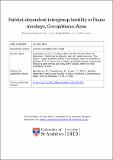Habitat-dependent intergroup hostility in Diana monkeys, Cercopithecus diana
Abstract
Territorial threat is costly and variable across contexts and behavioural flexibility is favoured to maximize any cost/benefit ratio. This is well illustrated in how animals react to familiar or unfamiliar outgroup members. In some situations, neighbours are better tolerated than strangers, resulting in a ‘dear-enemy effect’; in other situations, the pattern is reversed, resulting in a ‘nasty-neighbour effect’. Typically, the effects are species-specific traits, although both can also occur within the same species. Here, we investigated wild Diana monkeys of Taï Forest (Ivory Coast) in their reactions to outgroup individuals using playbacks of both familiar and unfamiliar male alarm calls to eagles. We found that groups living in primary forest (high group density, high food availability and low predation pressure) followed a ‘nasty neighbour’ strategy whereas groups living in secondary forest (low group density, low resources and high predation risk) followed a ‘dear enemy’ strategy, suggesting that group density, predation pressure and food availability can impact how hostile behaviour is displayed in nonhuman primates. Our results confirm a high behavioural flexibility in primate relationships between conspecifics of different identities depending on ecological traits of the habitat.
Citation
Decellieres , M , Zuberbühler , K & León , J 2021 , ' Habitat-dependent intergroup hostility in Diana monkeys, Cercopithecus diana ' , Animal Behaviour , vol. 178 , pp. 95-104 . https://doi.org/10.1016/j.anbehav.2021.06.001
Publication
Animal Behaviour
Status
Peer reviewed
ISSN
0003-3472Type
Journal item
Description
Authors thank the Centre Suisse de Recherches Scientifiques, the Ministère de la Recherche Scientifique and the Ministère de l’Agriculture et des Ressources Animales of Côte d’Ivoire for support and permission to conduct research in the Taï National Park.Collections
Items in the St Andrews Research Repository are protected by copyright, with all rights reserved, unless otherwise indicated.

